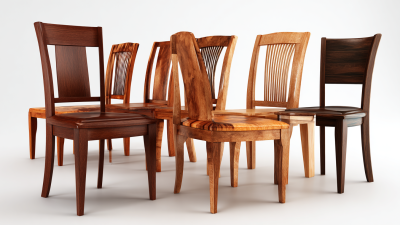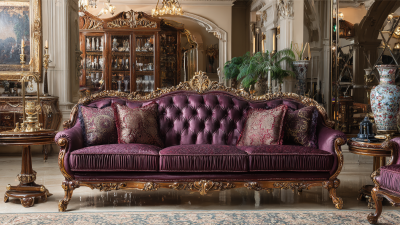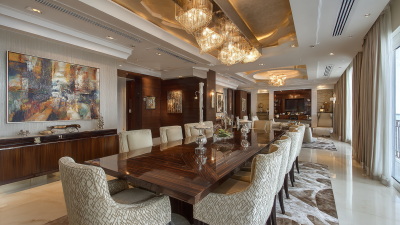
Blog
The Future of Dining Set Solid Wood Innovation and Design Trends
As the dining experience continues to evolve, the significance of quality materials and innovative designs remains paramount. Recent industry reports indicate that the global dining furniture market is projected to reach $35 billion by 2026, with solid wood dining sets gaining a substantial market share due to their durability and aesthetic appeal. The preference for sustainable materials is evident, with surveys showing that over 70% of consumers are willing to pay more for sustainably sourced wooden products. The trend towards minimalism and multifunctionality in home decor further underscores the relevance of Dining Set Solid Wood, as it combines elegance with practicality. This blog will explore the latest design trends and innovations in solid wood dining sets, highlighting comparisons that showcase their unique advantages and enduring charm in contemporary living spaces.

The Evolution of Solid Wood Dining Sets: Traditional Meets Modern
The evolution of solid wood dining sets reflects a fascinating blend of traditional craftsmanship and contemporary design sensibilities. According to a recent report from the American Home Furnishings Alliance, approximately 70% of consumers prioritize durability and longevity when selecting dining furniture, highlighting the enduring appeal of solid wood. This material, celebrated for its strength and aesthetic, serves as a canvas for innovative designs that marry function with artistry.
Modern trends lean towards minimalist aesthetics and adaptable functionality, with solid wood dining sets featuring clean lines, integrated storage solutions, and modular components. A study by Grand View Research states that the global wood furniture market is projected to reach $260 billion by 2027, driven by an increasing demand for sustainable and customizable options. This shift encapsulates a broader desire for dining environments that reflect both personal style and environmental responsibility, ensuring that solid wood remains a sought-after choice that bridges the gap between tradition and modernity.

Sustainable Innovations in Solid Wood Furniture Design
As the world becomes increasingly conscious of environmental impacts, the future of dining set design is leaning heavily towards sustainability. Solid wood furniture, long cherished for its durability and timeless appeal, is now at the forefront of eco-friendly innovations. Designers are incorporating reclaimed wood and responsibly sourced materials to create stunning pieces that not only serve practical purposes but also minimize carbon footprints. This fusion of functionality and environmental stewardship is shaping how we perceive dining spaces.
Moreover, innovative manufacturing processes are enhancing the aesthetic and functional qualities of solid wood furniture. Techniques such as steam bending and modern joinery are making it possible to craft intricate designs while ensuring longevity. Customization options are also expanding, allowing individuals to personalize their dining sets in ways that reflect their values and lifestyle preferences. This shift toward sustainable innovations in solid wood furniture design is not just about aesthetics; it's a movement towards a more responsible and conscious consumption, aligning our dining environments with the values of sustainability and quality craftsmanship.
Integrating Technology into Dining Experiences: The New Age of Smart Tables
As we step into a new era of dining experiences, the integration of technology into solid wood dining tables is revolutionizing the way we gather around the dinner table. Smart tables, equipped with features designed to enhance usability and convenience, are becoming the centerpiece of modern dining. Imagine a table that not only serves as a stunning focal point in your dining room but also incorporates smart technology to elevate entertaining and casual meals alike. From built-in wireless charging pads to integrated sound systems, these innovations are designed to blend seamlessly with the timeless beauty of solid wood, offering both aesthetic appeal and functionality.

Beyond mere convenience, these smart tables can facilitate interactive dining experiences. With digital features such as embedded touchscreens, guests can browse recipes, access streaming services, or even play games, all while enjoying their meal. This technological integration fosters connections, encouraging social interaction in a way that traditional dining setups cannot. As smart tables gain popularity, they invite a new wave of design trends that marry traditional craftsmanship with cutting-edge technology, ultimately transforming the dining experience into a dynamic and engaging event. The future of dining is not just about the food served but also about the environment created, and smart tables are leading the charge in this evolution.
Trendy Aesthetics: Color Palettes and Finishes for Solid Wood Dining
In recent years, the aesthetics of solid wood dining furniture have undergone significant transformations, driven by evolving consumer preferences and innovative design trends. According to a report by Grand View Research, the global wooden furniture market is expected to reach USD 661.41 billion by 2025, underscoring a rising demand for aesthetically pleasing and sustainable dining options. This surge can be attributed to the growing importance of interior design in creating harmonious living spaces, where color palettes and finishes play a crucial role.
Contemporary trends favor warm, earthy tones coupled with vibrant accents, appealing to a wide demographic. Rich walnut and oak finishes remain popular, but designers are now integrating bolder colors such as deep greens and navy blues to create striking contrasts. The use of environmentally friendly stains and finishes is also on the rise. According to a survey by the American Home Furnishings Alliance, over 70% of consumers prefer sustainable products, pushing manufacturers to innovate further in creating eco-conscious yet stylish dining solutions. Such trends not only enhance the visual impact of solid wood pieces but also align with the consumer shift towards responsible consumption.
The Role of Customization in Personalizing Solid Wood Dining Sets
Customization has become a guiding principle in the design of solid wood dining sets, transforming them from mere furniture pieces into personalized expressions of individual style and lifestyle. Homeowners are increasingly seeking unique solutions that reflect their tastes and needs, leading designers to explore a multitude of options in materials, finishes, and configurations. From choosing the type of wood, whether it be rich mahogany or sustainable oak, to selecting the perfect stain or paint finish, customization allows consumers to curate a dining experience that complements their home décor and personal aesthetic.
Moreover, customization extends beyond aesthetics; it accommodates the diverse functional requirements of modern lifestyles. Families can design dining sets that fit specific dimensions or configurations, ensuring that their space is utilized effectively. This adaptability means that whether someone prefers a sprawling table for large family gatherings or a compact setup for an urban apartment, solid wood dining sets can be tailored to fit these varying needs. By combining innovation in design with the art of personalization, the future of dining furniture is not just about form, but also about the unique stories and experiences shared around the table.
The Future of Dining Set Solid Wood Innovation and Design Trends - The Role of Customization in Personalizing Solid Wood Dining Sets
| Design Trend | Customization Option | Materials Used | Target Consumer | Price Range (USD) |
|---|---|---|---|---|
| Modern Minimalist | Size and Finish | Ash, Oak | Young Professionals | 500 - 1500 |
| Rustic Farmhouse | Wood Stain Color | Reclaimed Wood | Families | 800 - 2000 |
| Scandinavian Chic | Leg Style and Height | Birch, Pine | Eco-conscious Consumers | 600 - 1700 |
| Industrial Style | Finish and Texture | Teak, Metal Accents | Urban Dwellers | 700 - 1800 |
| Contemporary Elegance | Custom Carvings | Walnut, Cherry | Luxury Buyers | 1000 - 3000 |
Related Posts
-

How to Choose the Perfect Wood Dining Chairs for Your Home Based on Expert Recommendations
-

Creative Wooden Desk Legs Designs: Unique Examples to Transform Your Workspace
-

Solutions for Elevating Your Space with the Best Luxury Furniture
-

The Definitive Handbook to Choosing Modernist Dining Chairs for Every Home
-

Challenges Faced When Choosing Breakfast Bar And Stools in Modern Kitchens
-

Discover Reliable Chinese-Made Dining Room Furniture: Quality You Can Trust for Global Markets
